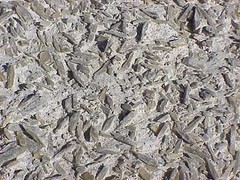 In the heart of New Mexico's Tularosa Basin lies the world's largest gypsum dune field. Originating in an ancient lakebed, the wind-driven gypsum sands have engulfed 275 square miles (700 kM) of desert. But the snow-white gypsum sands are only part of the story of White Sands National Monument.
In the heart of New Mexico's Tularosa Basin lies the world's largest gypsum dune field. Originating in an ancient lakebed, the wind-driven gypsum sands have engulfed 275 square miles (700 kM) of desert. But the snow-white gypsum sands are only part of the story of White Sands National Monument.
To the west of the dune field lies a low, extremely flat area called the Alkali Flat. The southern end of the Alkali Flat, called Lake Lucero, is a depression that occasionally fills with water.
The Alkali Flat and Lake Lucero are remnants of a much larger lake that once occupied the Tularosa Basin. Together they constitute the primary source of gypsum sand that forms the dune field.
Lake Otero
Lake Otero during last Ice Age. Covered 1,600 square miles. The mountains that surround the Tularosa basin contain large amounts of gypsum, exposed in the light-colored layers of rock near the top of the San Andres Mountains to the west and the Sacramento Mountains to the east. During the last ice age (about 24,000 to 12,000 years ago) the climate was much cooler and wetter than today. Large amounts of rain and snow fell on the surrounding mountains and a glacier formed on Sierra Blanca, the high peak to the northeast.
During the last ice age (about 24,000 to 12,000 years ago) the climate was much cooler and wetter than today. Large amounts of rain and snow fell on the surrounding mountains and a glacier formed on Sierra Blanca, the high peak to the northeast.
Rain and snowmelt from the mountains dissolved gypsum (calcium sulfate), salt (sodium chloride), and other soluble minerals from the rocks and carried them into the basin.
Normally, water from the mountains would flow into rivers and be carried to the sea, but the Tularosa Basin has no outlet. With no way to escape, the gypsum-laden runoff filled the lower parts of the basin and created a 1,600 square mile (4,100 kM2) lake known as Lake Otero.
For perhaps 20,000 years Lake Otero occupied the Tularosa Basin. Silt, clay, and millions of tons of dissolved gypsum were washed from the mountains into the lake. About 12,000 years ago the climate changed again. With the end of the ice age, less rain fell on the mountains and warming temperatures began to dry up Lake Otero.
Selenite Formation
As the water in Lake Otero slowly evaporated, the dissolved gypsum in the lake gradually increased in concentration to the point where the water became saturated. In the muddy floor of the shrinking Lake Otero, gypsum crystals (CaSO4.2H20) began to form. Known as selenite, these knife-like gypsum crystals grew to be as much as four feet long. By about 4,000 years ago, Lake Otero had completely evaporated, leaving behind a dry lake bed, or playa, now called the Alkali Flat. Beneath the clay and silt surface of the Alkali flat the gypsum, now in crystal form, was waiting for the wind.
By about 4,000 years ago, Lake Otero had completely evaporated, leaving behind a dry lake bed, or playa, now called the Alkali Flat. Beneath the clay and silt surface of the Alkali flat the gypsum, now in crystal form, was waiting for the wind.
Wind Action
Southwest winds scour the Alkali Flats at Lake Lucero. After Lake Otero evaporated, strong southwesterly winds, typical of this area since the end of the ice age, swept across the Alkali Flat. The winds picked up small particles of clay and silt from the playa surface and carried them high into the atmosphere and out of the area.
As wind erosion removed the surface material and lowered the level of the Alkali Flat, the selenite crystals were exposed. The forces of nature - freezing and thawing, and sandblasting by wind-eventually broke down the crystals into sand-size particles.
Unlike the fine silt and clay particles, sand grains are too heavy to be carried very far by the wind. Instead, the wind tends to bounce sand along the ground, a few inches at a time. This bouncing movement is called saltation. The southwesterly winds bounced the selenite particles across the Alkali Flat toward the northeast. As more crystals disintegrated, gypsum sand began to accumulate downwind of the Alkali Flat, and the white sands were born.
The southwesterly winds bounced the selenite particles across the Alkali Flat toward the northeast. As more crystals disintegrated, gypsum sand began to accumulate downwind of the Alkali Flat, and the white sands were born.
Lake Lucero
On rare occasions the lowest part of the alkali flat, at the extreme southern end, still fills up with water. After heavy rains, about ten square miles (26 kM2) may be flooded, creating a temporary lake known as Lake Lucero.
While Lake Lucero is only a small fraction of the size of Lake Otero, its ice age predecessor, it is a critical link in the geologic process that continues to produce gypsum sand.
Beneath the surface of Lake Lucero, selenite crystals continue to form, even during periods when there is no standing water. Because runoff from the mountains cannot escape to the sea, the soils of the basin contain vast amounts of water very close to the surface. At Lake Lucero, the water table is usually only two to four feet (.6 to 1.2 m) below ground.
From this shallow depth, ground water, heavily laden with dissolved gypsum, moves upward to the surface of Lake Lucero through capillary action. As the water approaches the playa surface, it evaporates and selenite crystals form in the mud just beneath ground level. A thin, puffy crust of gypsum may also form on the surface of Lake Lucero. Lesser amounts of other soluble minerals, such as sodium chloride (table salt) and magnesium sulfate (Epsom salt), may also be deposited as groundwater evaporates on the surface.
A thin, puffy crust of gypsum may also form on the surface of Lake Lucero. Lesser amounts of other soluble minerals, such as sodium chloride (table salt) and magnesium sulfate (Epsom salt), may also be deposited as groundwater evaporates on the surface.
This surface crust, along with non-gypsum clay and silt washed into Lake Lucero during rainstorms, eventually breaks down into fine particles and is swept away by the wind. Selenite crystals are then exposed to the forces of erosion and break down into sand-size fragments that are blown into the dune field.
Thus, the same processes that operated thousands of years ago at Lake Otero continue to operate, on a much smaller scale, at present-day Lake Lucero.
While most of the sand that comprises the dune field probably originated on the Alkali Flat, today Lake Lucero is the primary source of gypsum sand for the dune field
Building a Backyard Observatory on a Budget
-
Welcome to our guide on building a backyard observatory on a budget. A
backyard observatory is a permanent shelter that protects your telescope
and lets ...
2 weeks ago




.jpg)









0 Comments:
Post a Comment
I love and appreciate comments - however - comment spam will be deleted when discovered. A big thank you to every one else for taking the time to put your two cents in.